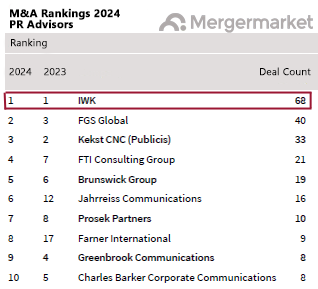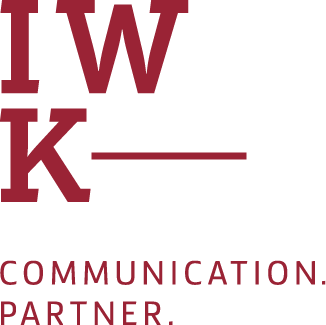TRANSACTION
COMMUNICATION
There are many different facets to M&A communication and just as many target audiences. Extensive experience and an excellent network of contacts are essential for designing and implementing a tailored communication strategy for any acquisition, merger and investment.
COMMUNICATION SPECIALIST
FOR THE M&A PROCESS
Deals that work out
While specialists ensure due diligence, investment banks and M&A consultants take care of the financial aspects, and tax consultants, lawyers and notaries set up the framework of a deal, IWK is the reliable communication partner for successful transactions: on average one per week. The buying and selling of businesses (or business units), mergers, investments or growth financing are delicate and complex processes, which often harbour many pitfalls, but also unused chances when it comes to the communication surrounding them. To avoid the pitfalls and capitalise on the chances, IWK supports buyers, investors and sellers as well as the involved transaction consultants as an experienced partner for the communication with employees, customers and clients, suppliers, other stakeholders and the media.
Our experts support family-owned businesses during succession proceedings, management teams during MBOs/MBIs, industrial holdings during carve-outs, founders during funding rounds, and private equity companies, family offices, and venture capital firms as well as law firms and corporate finance advisors with their deal communication.
Top ranking by Mergermarket
According to the current ranking “PR Advisors – Global and Regional League Tables” by M&A industry observer Mergermarket for the year 2024, IWK Communication Partner once again occupies first place on the podium of PR agencies that have supported the most transactions in Germany in the last twelve months.
As a German boutique agency, IWK Communication Partner is also ranked 9th in Europe and 12th place wordwide. During the reporting period, IWK advised around a dozen private equity and venture capital companies as well as M&A advisors. One focus was on supporting small and mid-cap deals.

STAKEHOLDER
COMMUNICATION –
A CHALLENGE OF
DEAL COMMUNICATION
Due diligence is done, all legal and fiscal questions have been answered, the contracts for the notary appointment are ready and all of the owners support the decision. In short, the deal is cut and dried. However, isn’t there something missing? There is: Too often, informing the internal and external stakeholders is a low priority during this process, but ignoring or blindsiding important stakeholders makes it impossible to build the trust that is necessary for the transaction to truly succeed. Consequently, the following five aspects should be part of any deal preparation (originally published as a guest article in German in the specialist magazine “Die Unternehmervertrauten”):
Don’t forget any of the target audiences. – To ensure employee commitment in the future, communicating with them clearly and respectfully is essential. Employees shouldn’t learn about a change in ownership via third parties (for example by reading about it in the newspaper), but should instead hear it directly from the owner. This is especially important if the business has recently endured a period of uncertainty. Also important: Getting employee representatives on board and keeping the management – department managers, floor managers and team leaders – up to date, so they can serve as change ambassadors. For external communication purposes, it is vital to address business partners such as customers and clients, suppliers, service providers, banks, landlords as well as specialist, business and local media individually. The same is true for other stakeholders (such as mayors, local and state governments, promoters and advocates of local business, chambers of trade and commerce, and other local businesses) as well as industry associations.
Consider the timing. – Finding the right point in time to communicate is crucial: If stakeholders know about a planned sale too early, they might develop doubts. Therefore, sellers should consider the timing carefully and also make provisions for the fact that a deal could potentially still fail before signing or closing. An approach which has repeatedly proven itself is to personally inform all employees on signing day or the day after at the latest. This is also the earliest point in time when the media should be involved. Any consultants who are involved in the process have to be obliged to wait for a later date to initiate their own communication measures.
Get everything ready for Day X. – A Q&A catalogue for the transfer period, which has been designed together with the buyer, should serve as the basis on which all communication channels and measures are employed: Why is the sale happening and who is the buyer? Is the business sold to a competitor or an investor? Will the previous owner remain with the company, for example as a member of the advisory board or a minority shareholder? Is the sale happening as a result of a crisis? In general, any critical questions should be anticipated beforehand and – if possible – answered with the help of an experienced communication consultant.
Focus on the future. – A strategic follow-up communication helps all target audiences to understand owner or shareholder changes and to remove doubts. It can also potentially create an optimistic climate and generate momentum: Explain the reasons for your decisions, advocate for trust in the new owner, and create a clear vision for the company future. Anticipate potential questions in regard to timing, the company’s current situation and that of its client relations, its positioning in the future, job security and the status of other branches. You should also use this opportunity to express gratitude to the employees and try to communicate clearly and authentically instead of formalistically and dispassionately. In the end, the means and style of communication have to fit the company culture and the value of symbolic actions and gestures should not be underestimated.
Clearly assign roles and responsibilities. – Also valid for the new owner: Through personal conversations, staff meetings, intranet messages or a special edition of the employee magazine, a wide range of communication options is available. In that regard, one aspect is crucial, and that is to actually be available for conversation with the employees. An interview with a local newspaper or specialist publication to illustrate the medium-term strategy for the recently acquired company can also be a good idea, because the transfer of the company to a new owner and therefore the start of a new chapter in the company’s history also means that it must be clarified who speaks for the company and its strategy now. Consequently, the previous owner should avoid any public statement about the company from that point forward: Even if it may be hard to accept at first, someone else is now in charge.
THOSE WHO DO NOT EXPLAIN, WILL BE EXPLAINED
25 Years of Communication in Private Equity and Venture Capital
Over the past 25 years, Private Equity and Venture Capital have undergone a remarkable development. Through the lens of communication, this change becomes particularly clear – from optimism to scandalisation and retreat, to an increasingly professional communication culture.
The “Locust Debate”: A Communicative Storm
In 2005 came the speech by Franz Müntefering, in which he referred to investors as “locusts.” Suddenly, Private Equity firms were at the center of public debate – as threatening return hunters. Cover stories, accusations, and moral judgments dominated. The reaction? Retreat. Interviews were cancelled, many remained in a state of shock.
In the mid-1990s, Private Equity was still an exotic subject in Germany, at least to the general public and many target groups. Venture Capital sounded like Californian experiments, and with Private Equity the basics often had to be explained first: What is a fund model? Why is it not speculation, but long-term value creation? Communication back then was above all educational work – almost like remedial teaching in capital market studies.
The Turning Point: From Silence to Strategy
But silence did not protect. Investors realized: those who do not explain their work will be talked about – and rarely in a positive way. Communication became strategic: creating transparency, gaining trust among investors, entrepreneurial families, and politics, building reputation.
Today: Communication as Value Driver
Today, 20 years after the “locust debate,” communication is a fixed part of every successful strategy:
- Fundraising: Investors are convinced not only by numbers, but by a story.
- Transactions: Entrepreneurial families sell only to partners they trust.
- Portfolio development: Employees, customers, and suppliers want to see stability.
- Social responsibility: Sustainability and responsible investing have become a matter of course – but must also be communicated as a clearly recognizable stance.
New Channels: Shaping Visibility
Communication today no longer takes place only in the traditional media. Podcasts, LinkedIn, and storytelling formats on one’s own website have become central arenas. They offer opportunities to set one’s own agenda – but demand a clear strategy: How do we want to be perceived, which messages do we want to send, and which topics can we raise? How can USPs and core messages be credibly conveyed and have a lasting impact on the recipient? Which format fits the brand and the target group? Those who act carelessly here quickly lose credibility. Those who communicate strategically, structured, and with substance will in future not only be found by traditional search engines but also stand out in AI queries.
Communication Remains a Key
Private Equity and Venture Capital have grown up – and with them communication work. From an exotic niche topic it has become a field in which trust and visibility determine competitive advantage. Especially now, in times of geopolitical uncertainty and digital upheaval, the following applies: communication is not an accessory. It is a value driver. Or, to put it pointedly: those who do not explain, will be explained.
This article first appeared in German as a guest contribution by Ira Wülfing (IWK) on the occasion of the 25th anniversary of Venture Capital Magazine.

